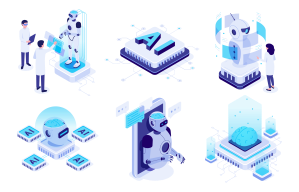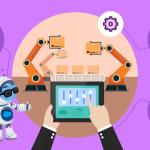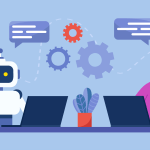From voice assistants and chatbots to generative tools and intelligent agents, businesses and consumers alike are interacting with different types of AI every day. Indian enterprises, in particular, are exploring multiple forms—predictive, generative, assistive and agentic —to personalise experiences, boost productivity, and make every customer interaction more meaningful.
But not all types of AI are created equal. Some follow predefined rules. Others learn from data, adapt to new scenarios, and even replicate human-like creativity. As the adoption of AI accelerates—set to reach 1.2 billion users by 2031—it becomes essential to understand what sets these systems apart.
In this guide, we break down the types of AI — by capability, function, and the technologies that power them to help you navigate this fast-moving field and choose the right tools for your needs.
Table of contents
- What is Artificial Intelligence?
- The 3 Major Types of AI (By Capability)
- Classifying AI by function: 4 key models
- Reactive Machines
- Limited Memory
- Theory of Mind
- Self-Aware AI
- Core Technologies Powering AI Systems
- Machine Learning (ML)
- Deep Learning
- Natural Language Processing (NLP)
- Robotics
- Computer Vision
- How different types of AI impact businesses
- Frequently Asked Questions (FAQs)
What is Artificial Intelligence?
Artificial intelligence is the ability of machines to perform tasks that typically require human intelligence. That includes learning from data, understanding language, recognising patterns, making decisions, and solving problems.
At its core, AI is not a single mechanism, but a combination of multiple technologies, which include machine learning (ML), natural language processing (NLP), computer vision, robotics, and more. These systems can be data-driven or rule-based, and can operate with or without human supervision.
At Salesforce, we define AI as the ability to make machines smart so that they can support—not replace—human effort. For us, intelligence means more than speed; it means systems that adapt, converse, and understand context. That’s why we design AI to work with people, not around them. Whether it’s handling repetitive tasks or unlocking insights at scale, our approach puts humans in charge—steering outcomes, applying judgment, and ultimately shaping experiences that drive customer success.
Trusted AI needs a human at the helm.
Read all about how we put this into practice.



The 3 major types of AI based on capabilities
One of the most common ways to categorise AI is by capability. Essentially, we can measure how intelligent or autonomous an AI system is by comparing its ability to accomplish specific tasks.
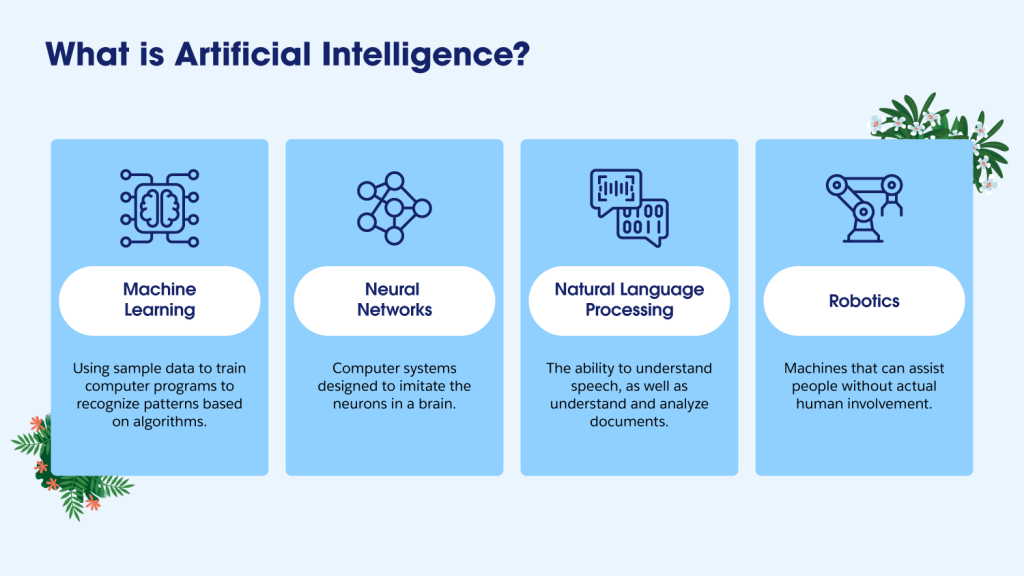
Narrow AI (Weak AI)
Most of the AI systems we use in our day-to-day lives fall under this category. Narrow AI systems are designed to accomplish a specific set of tasks, and their capabilities are restricted to what they are trained to do.
Examples of narrow AI systems include
- Voice assistants, like Google Assistant and Siri
- Generative AI platforms
- Chatbots and virtual agents
- Email spam filters
- Recommendation engines on OTT platforms, etc.
Narrow AI systems can be incredibly powerful for the tasks they are designed to accomplish. Their strength lies in completing their specific tasks quickly and precisely, making them ideal for single-case scenarios.
If you’re wondering why generative AI platforms are categorised as “weak”, it is because the AI model is limited to a single task in a primarily text-based chat.
General AI (Strong AI/AGI)
A step up from narrow AI systems, general AI can perform any task that a human can. These types of AI systems have the ability to understand context, learn from minimal input, reason, and adapt to new situations without the need to be reprogrammed.
As of 2025, a strong AI system only exists theoretically, with significant ongoing work to create AGI systems. Yoshua Bengio (Mila), Demis Hassabis (DeepMind), and Ian Goodfellow (Apple) are some of the most prominent people working in AI research, pushing the boundary of deep learning, neural networks, and advanced machine learning techniques.
Additionally, several startups are working to developing AGI systems. These include Xephor Solutions (quantum neural networks for human-like tasks), GoodAI (AGI software), Avatar Cognition (synthetic cognition), Aleph Alpha (augmented intelligence), and SingularityNET (decentralized AI networks).
Superintelligent AI (ASI)
A concept for the distant future, superintelligent AI is one of the most advanced types of agent AI. These systems will not only replicate but surpass human intelligence, excelling in logic, creativity, problem-solving, emotional intelligence, and everything else.
Currently, this type of AI is more of a subject of ethical, philosophical, technical, and safety discussions than development. Here are some of the key challenges in developing ASI models :
- Energy demands: Unlike the human brain, which functions at a measly 20 watts, current silicon-based computers are about 2.7×10^13 times less efficient. The development of ASI agents is highly dependent on radical advancements in computing technology.
- Common-sense reasoning gaps: Even the most advanced AI systems currently struggle with common-sense reasoning gaps, such as understanding implicit context and making connections between facts that are trivial to humans but not explicitly stated in data. This problem emerges from AI’s reliance on pattern recognition rather than a genuine understanding of the world.
- Alignment and safety risks: Safeguards should be in place against harmful or misaligned objectives. Deep learning models often use a black box method, making it difficult to predict or control their behaviour.
- Computational theory barriers: There are inherent theoretical limits to what can be computed (such as NP-hard problems), and some questions are undecidable (such as the Halting Problem). Additionally, AI cannot generalise knowledge across domains as easily as humans do.
Classifying AI by function: 4 key models
Another method of classifying different types of AI is by taking a look at how the AI functions, i.e., what it does with the inputs fed into the system and how much awareness it has of the domain. There are primarily four categories that show the functional depth of AI systems.
- Reactive machines
Reactive machines are the most basic AI models, which, as the name suggests, react to inputs with pre-programmed responses. However, they do not store memory or learn from previous actions.
Example: One of the most famous reactive machines is IBM’s Deep Blue chess engine, which fought and won against then world champion Grandmaster Gary Kasparov in 1997. Deep Blue analysed moves in real time, but did not learn from previous games.
- Limited memory
Most AI systems we use today fall under this category. These machines can reference short-term data from previous interactions to make decisions.
Examples: Chatbots that retain context from one chat during one session, and self-driving cars that use sensor data and recent movement history. The most prominent use of limited memory AI systems is Generative AI, such as ChatGPT and Claude, which use memory contexts to predict the next word, phrase, or image within the content it is generating.
An example of Limited Memory systems is SharkNinja’s use of Agentforce to deliver real-time, personalised service at scale—using current and historical consumer data to generate instant answers, while still preserving the flexibility to escalate complex issues to human agents. Read more about it here.
- Theory of mind
This is an emerging field of artificial intelligence that aims to understand the emotions, beliefs, and intentions behind conversations. The theory of mind is named after the psychological concept, which refers to humans’ ability to attribute mental states to others.
While no fully functional model has been developed yet, AI with the theory of mind could collaborate better with humans and improve daily operations.
- Self-aware AI
The most advanced systems on this scale, self-aware AI will have consciousness and a sense of self, which will allow it to understand not only human emotions but also its role and impact.
Self-aware AI systems are still in the realm of science fiction and a constant area of technological and ethical debate.
Types of AI technologies driving innovation
Behind every functional capability of AI systems lies a technology that powers it. These core technologies define how AI systems learn, adapt, reason, interact, and improve. Here’s a breakdown of the most important technologies powering AI systems in 2025.
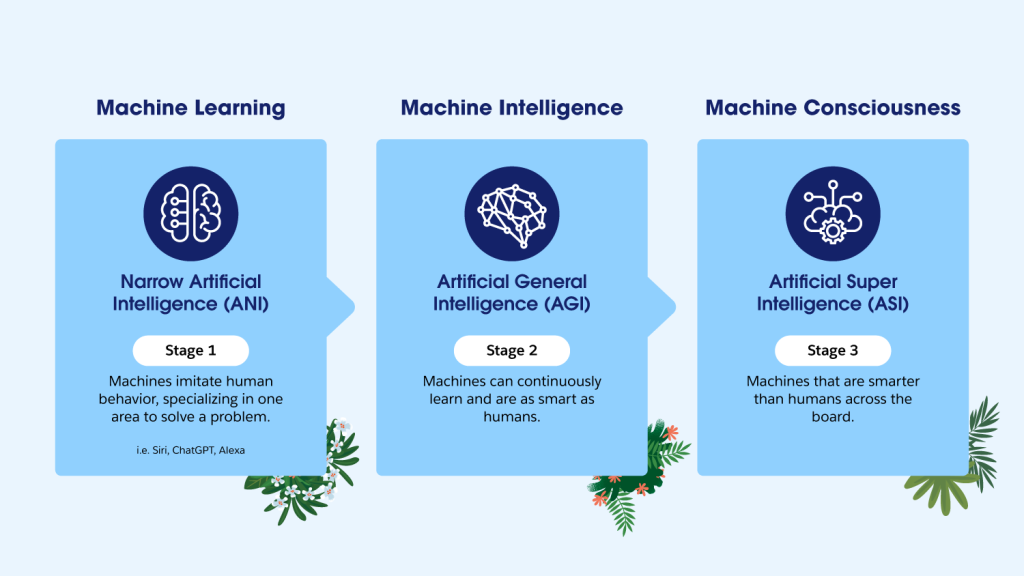
Machine learning (ML)
Machine learning is the backbone of modern AI systems. ML enables these systems to learn from a wide set of data without the need for explicit programming. For AI systems, ML primarily consists of the following:
- Supervised learning: Models that are trained on labelled data, such as spam filtering, etc.
- Unsupervised learning: Models that find patterns in unlabelled data, such as customer segmenting protocols in CRMs.
- Reinforced learning: AI agents that learn by the trial-and-error method to maximise rewards, such as AI games.
Deep learning
Deep learning is a subset of machine learning that focuses on using neural networks to mimic the way human brains process information. The “deep” in deep learning comes from the structure of the underlying neural network architecture. Unlike traditional machine learning, deep learning models use three or more (typically hundreds of) neural computational layers.
Due to the unique architecture, deep learning models can use unsupervised learning to analyse outputs and even rectify responses. It can extract the characteristics and features of input data to establish relationships, making responses more accurate.
Deep learning is an aspect of data science and powers several features, such as:
- Image recognition and creation
- Language translation
- Voice-enabled tech, e.g., remotes
- Credit card fraud detection
- Self-driving cars
- Generative AI, etc.
Natural language processing (NLP)
NLP is a field of AI that enables machines to understand, interpret, generate, and respond to human language. It does so by combining computational linguistics and rule-based modelling of human language with statistical modelling, machine learning, and deep learning.
NLP makes it easier for humans and machines to collaborate, driving several technologies like:
- Automation of repetitive tasks
- Chatbots and virtual assistants
- Sentiment analysis
- Enhanced search in search engines
- Language models, e.g., ChatGPT, etc.
Learn more about Natural language processing (NLP)



Robotics
Robotics is the physical application of artificial intelligence, deploying Narrow AI along with sensors and actuators to accomplish routine and repetitive tasks. In this context, robotics involves deploying AI principles into machines to create intelligent and capable robots.
Robotics with Narrow AI powers multiple industries. For instance, in healthcare, robots assist surgeons by monitoring vital patient stats and detecting potential issues during routine procedures. In agriculture, machines can help with pruning, moving, thinning, seeding, and spraying. In smart homes, smart cleaners can use computer vision and the stored floor plans to clean rooms at regular intervals.
Learn more about how real-world robotics is augmenting human work in high-stakes environments

Computer vision
Computer vision enables machines to ‘see’ the real world, unlocking an additional source of input for modern machines. Narrow AI apps can be trained to understand and interpret objects using images and videos, and classify them according to parameters set in pre-existing data.
Computer vision AI models are critical for machines that react to the physical world. Applications include:
- Smart home robots, such as cleaners
- Facial recognition technology
- Visual search
- Object tracking
- Image retrieval, etc.
Expert systems
Rule-based expert systems are AI tech that use logical inference to mimic the way humans make decisions. By using a knowledge base of facts, rules, and relationships, along with an “inference engine”, expert systems can apply logical reasoning and explain outcomes from large datasets.
These systems are used in industries where we need to draw conclusions from data sets, such as:
- Loan approvals
- Medical diagnosis
- Technical troubleshooting, etc.
Each of the technologies mentioned above shape the different types of AI systems that we see in our daily lives, whether it’s customer service bots, automated workflows, or generating insights from massive datasets. Some tech companies combine a few of these to increase the output and overall capabilities.
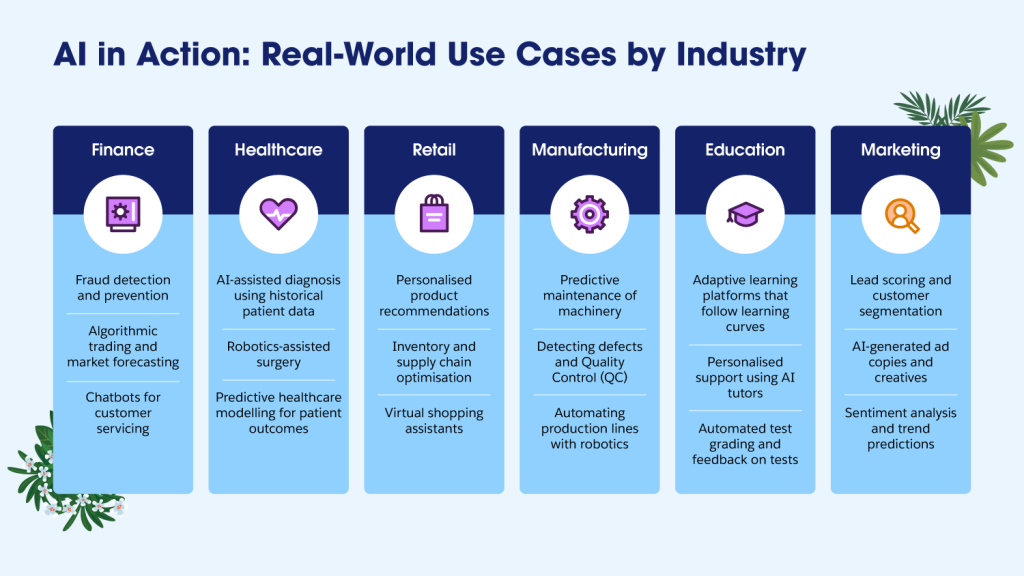
Let’s take a look at how different types of AI impact businesses in the real world.
How different types of AI impact businesses
- Narrow AI – building systems for efficiency
Narrow AI systems are excellent at automating repetitive tasks, making them perfect for sales predictions, content recommendations, and customer service chatbots.
In Salesforce, Einstein AI, which is embedded across the Salesforce ecosystem, uses narrow AI models to recommend the next best actions, personalise product offers, and auto-prioritise leads, all within your CRM.
- NLP, vision, and ML
When you combine NLP with machine learning, AI can do more than automate—it can understand. By pairing these two technologies, businesses can analyse sentiments in data, summarise conversations, and generate responses in real time.
Einstein Copilot and EinsteinGPT use natural language processing to help agents answer queries, streamline email replies, and boost productivity, all while ensuring data security through the Einstein Trust Layer.
Formula 1 tapped into this AI-first approach to cut service response times by 80%
Explore the full story.



- General AI – long-term strategic potential
While not yet realised, general and superintelligent AI are the obvious next leap in AI technology. Consistent efforts are being made in responsible AI research, governance frameworks, and scalable architecture that prepare companies for what is coming next.
As AI continues to shape the future of business and everyday life, understanding its types, functions, and underlying technologies isn’t just interesting — it’s essential. The more we grasp what these systems can (and can’t) do, the better we can use them to solve real-world problems, responsibly and effectively.
The next-gen agentic AI that combines automation with a human touch
Explore the future of AI-enabled intelligent service with Agentforce

Frequently Asked Questions (FAQs)
An AI model is a trained system that can perform specific tasks, such as recognising images, translating texts, or making predictions based on data.
AI is typically categorised based on capability, i.e., narrow, general, and superintelligent, or by function, i.e., reactive machines, limited memory, theory of mind, and self-aware.
Most businesses currently use narrow AI models, along with machine learning, NLP, and computer vision, to automate tasks, personalise customer experiences, and generate insights from datasets.
Narrow AI is purpose-built for specific tasks. It is used in chatbots, content recommendation systems, voice assistants, fraud detection systems, etc.
Agent-based AI systems can be reactive, proactive, or adaptive, depending on their functionality.
